Area 1 Nurse Tree Planting
7,325 nurse trees were planted in the 6.5 ha of Area 1 by Habitat Restorations Aotearoa in August 2023. Glen Riley, together with a crew of 4 or 5 committed conservationists worked through some harsh weather to plant an average of 560 trees per day. I helped out, folding the plant guards, picking up empty pots, and cooking the occasional barbecue.
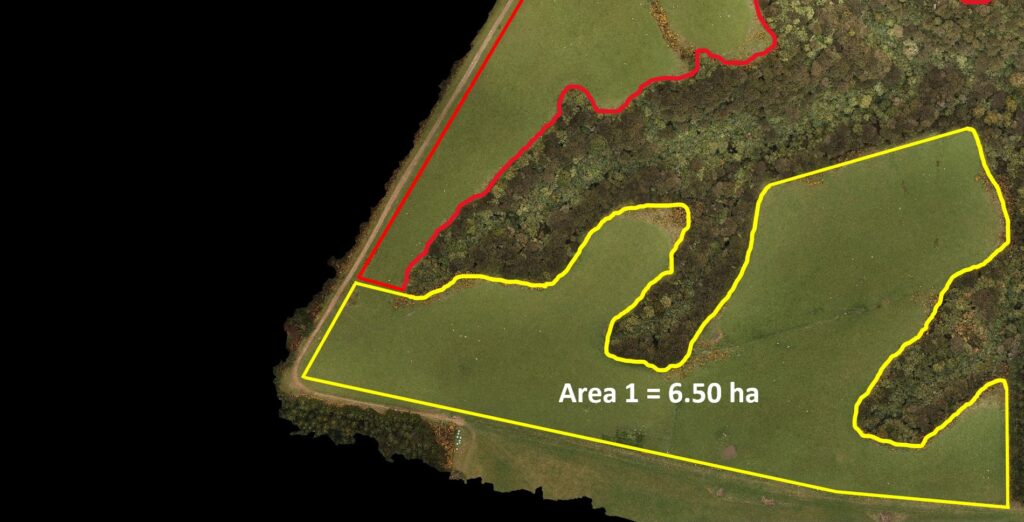
Preparation
Prior to planting, Mike Gorinski moved his sheep into the area to eat down the grass. After the sheep were moved off, Glen Riley from Habitat Restorations Aotearoa came in with the spray equipment to kill 1 m circles of grass for the tree planting. The circles will delay grass re-growth, helping prevent the young trees from becoming choked. Within a couple of weeks the grass had died off, ready for planting.
The program called for nominal 3 m centres for the nurse trees, but Glen knew I wanted contour planting, so there’s some variation. In areas of need (such as around the pond near the southern boundary), the circles are closer together.
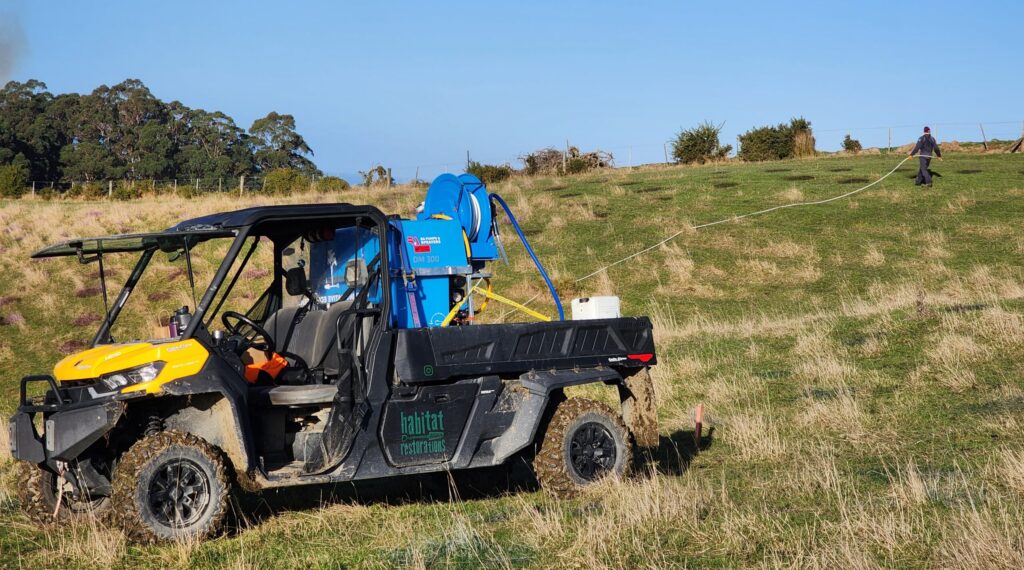
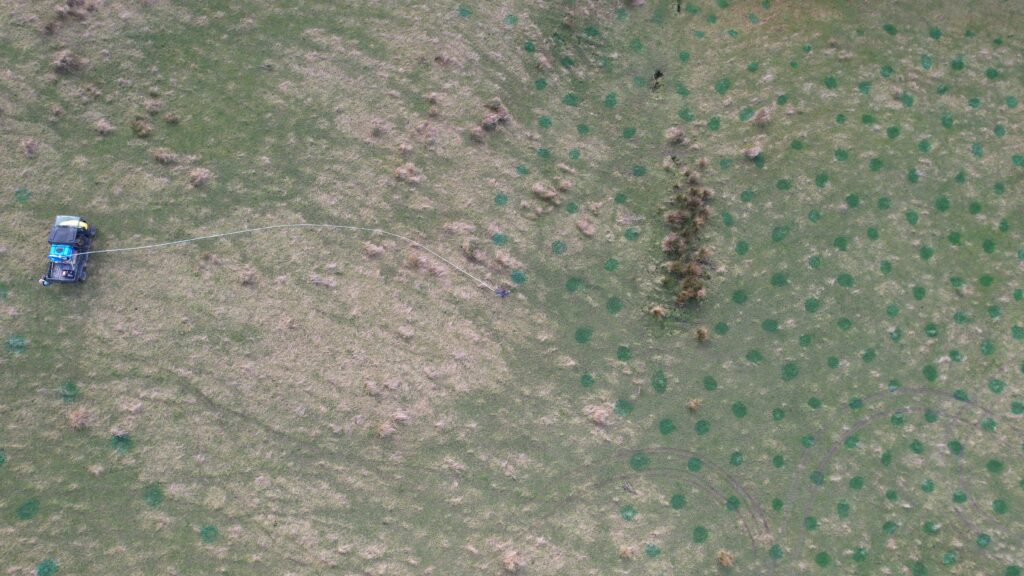
When discussing protection for the young trees from hares that come onto the property, I proposed installing a hare-proof mesh fence around the boundary. Glen Riley said that hares will still find a way in, and on-going monitoring and maintenance would be required. Once the hares were on the property, there would be no incentive for them to leave.
Glen recommended the use of tree guards to protect each tree. This also meant that if feral goats got onto the property, some trees may be saved. The guards also provide protection from the weather – wind, frost and snow. This became evident as soon as we started planting. The wind would have stressed the exposed trees, and the guards definitely helped with the snow.
We ordered 8,000 tree guards from Fiberguard. The guards are made from bio-degradable pulp fibre, and coated with a food-safe moisture barrier. They last around 2 years, rotting from the bottom up. That means that we won’t have 40,000 pieces of plastic blowing around the forest.
The tree guards come as a flat-pack kit, together with 2 bamboo stakes and a woollen mat. The guard is folded into a triangular prism. The vertex of the triangle (that also houses one of the bamboo stakes) is pointed towards the primary wind direction – in my case, predominantly north-west. The mat provides moisture retention in the summer and also prevents grass growing up inside the guard.
As the commencement date (2 August 2023) drew nearer, the plant guard kits were trailered to site. We used the old sheep yards on the southern boundary as the staging location for the equipment, side-by-side vehicle and trees.
A covered trailer was used to transport 600 plants per trip from Ribbonwood Nurseries. On most days, we picked up more trees. Because of the wind, it was better to make regular journeys than to stockpile all the trees in the sheep yards.
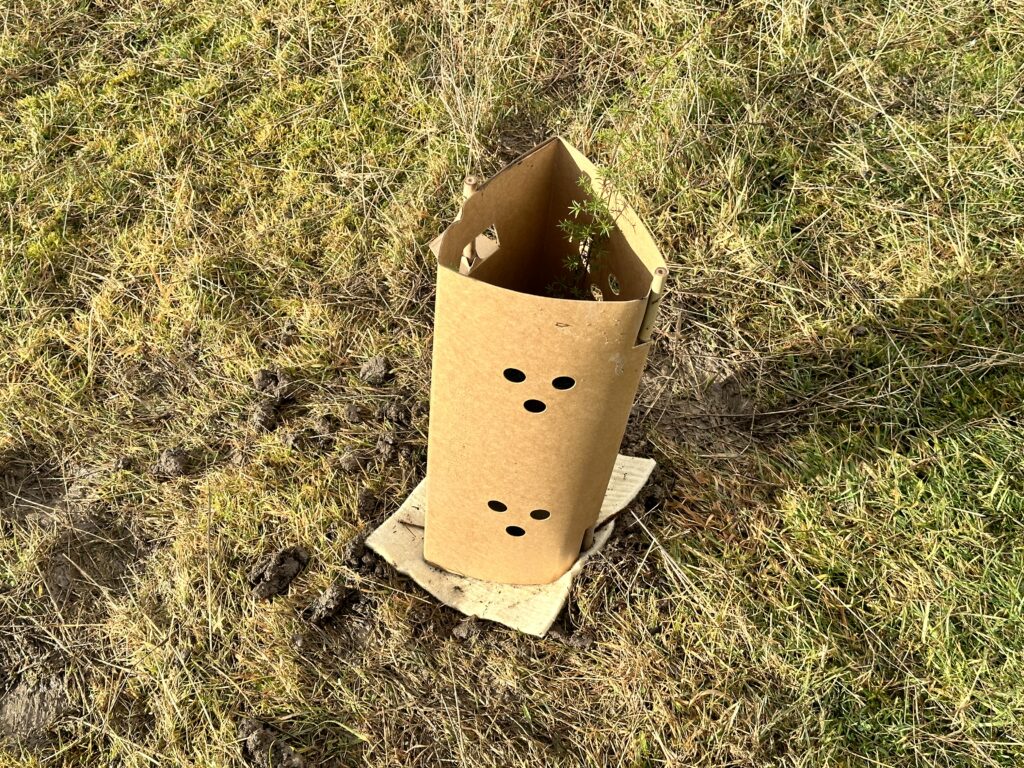
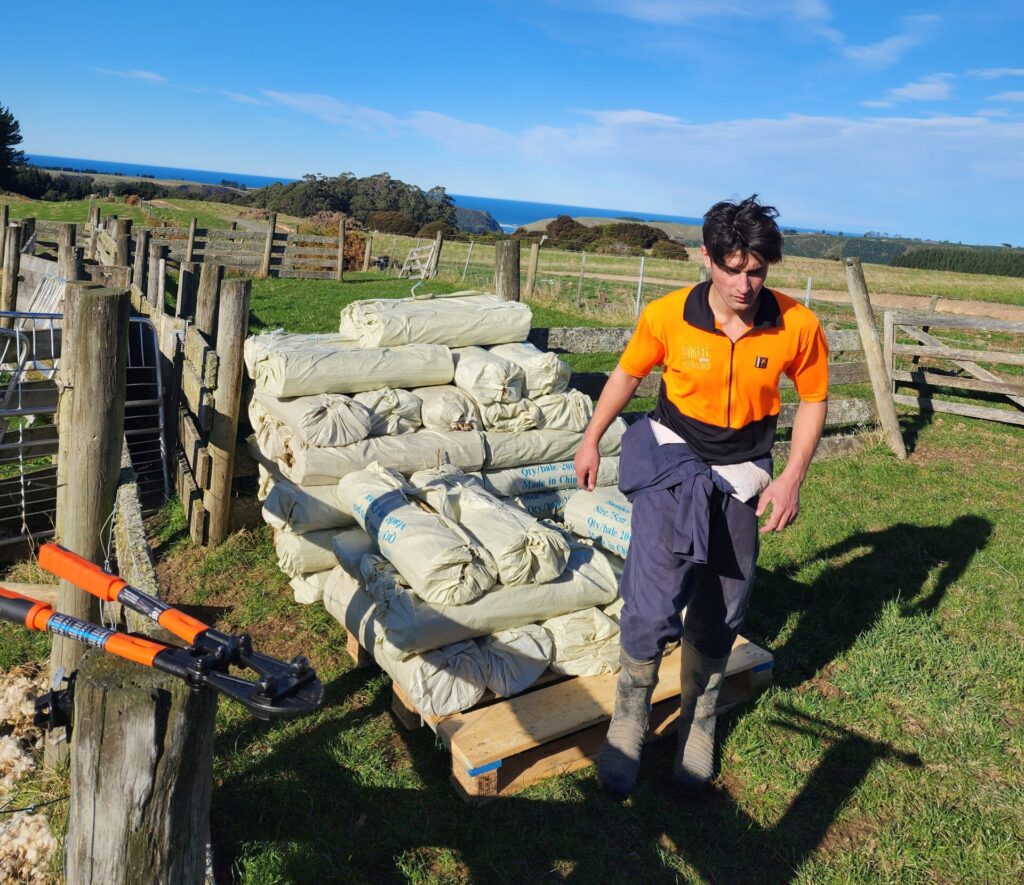
Planting
At the start of the planting, I introduced the project’s background and overall objective to the planting crew. It was great to have an opportunity to discuss the project, and the vision that I have for the final result.
The planting crew are all well-educated and knowledgeable environmentalists. They embraced the project’s objectives with enthusiasm and commitment. For all of us, this is a project of significance.
My introductory message can be seen in the KT012 video uploaded to the Kauri Trees YouTube channel.
Planting commenced on 2 August 2023. The plan was to finish in 13 working days. The Habitat Restorations Aotearoa planting crew was 4 or 5 people (depending on the day), led by Glen Riley. We each slipped into a primary roles:
- drilling holes with the auger
- placing the tree guard kits next to the hole
- allocating a tree
- folding the tree guards, and
- planting the trees.
The KT016 YouTube video short shows the planting steps.
The ground was wet underfoot, and it was interesting to see some plant holes filled with water within minutes of being drilled. A few metres away, other holes remained dry. Glen Riley selected suitable plants for the conditions. He was rather particular.
I focused my efforts on folding the tree guards and picking up empty plant pots. This left more time for the professionals to plant the trees. I was all fingers and thumbs when folding of the first tree guard, but I soon found my rhythm and could keep ahead of three planters.
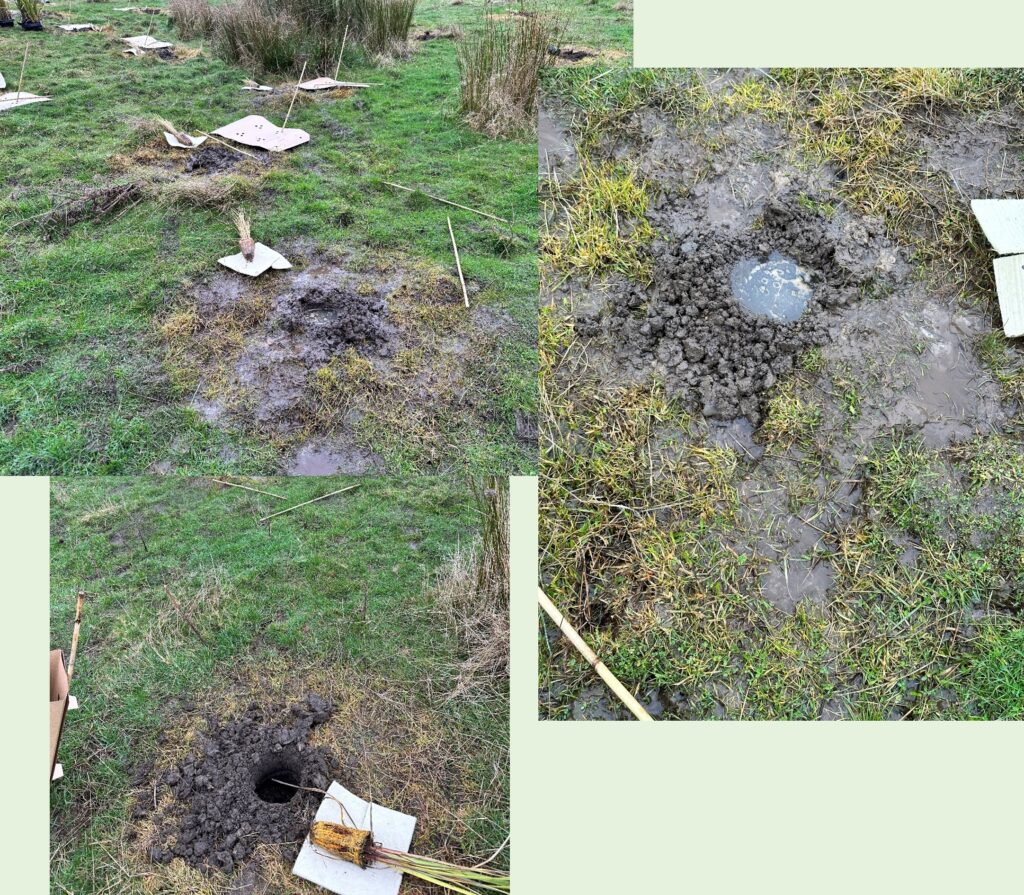
The weather was harsh in early August. Wind blew the guards away (they had to be staked in place using the bamboo sticks). Rain, sleet and snow made working conditions uncomfortable, especially for me because I wasn’t prepared with enough wet-weather clothing. My woollen gloves were great until they got wet (which happened immediately), then the water froze on the outside of the gloves. My Dunedin Airbnb host Barry Wilson, gave me a pair of fitters gloves, which were more waterproof.
I casually asked one of the women if they stopped work when it was snowing. She replied that they don’t, but I could. With an answer like that, how could I?
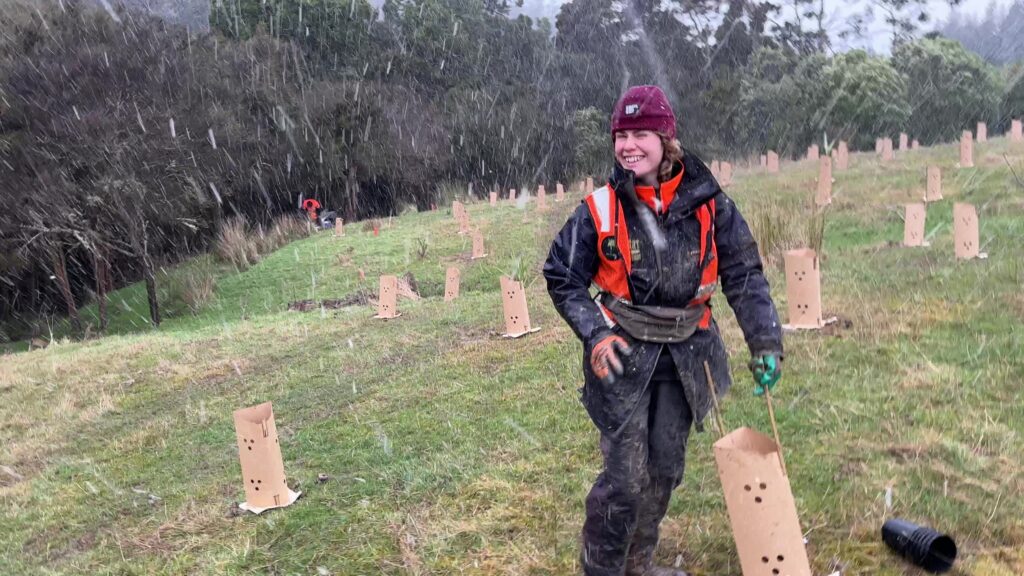
The pasture in the north-east corner of Area 1 has developed a few sink holes about 1 m deep, in the trough of the land. It appears as if two small gullies had been filled in with soil. The soil had been pushed around (probably by a bulldozer) created a sharp drop just inside the line of the existing forest. But the water that had been running in those gullies was eroding the infill, causing the soil to collapse in three separate locations.
It was Glen Riley who pointed out the feature to me, noting the clumps of rushes that were growing at the head of the “gully” areas. Maybe there’s an underground source of water here too? Glen said that if the soil was going to collapse, then any trees would also fall. The immediate area was planted in flax, that will be able to survive a collapse, and then recover (another example of the value added by Glen).
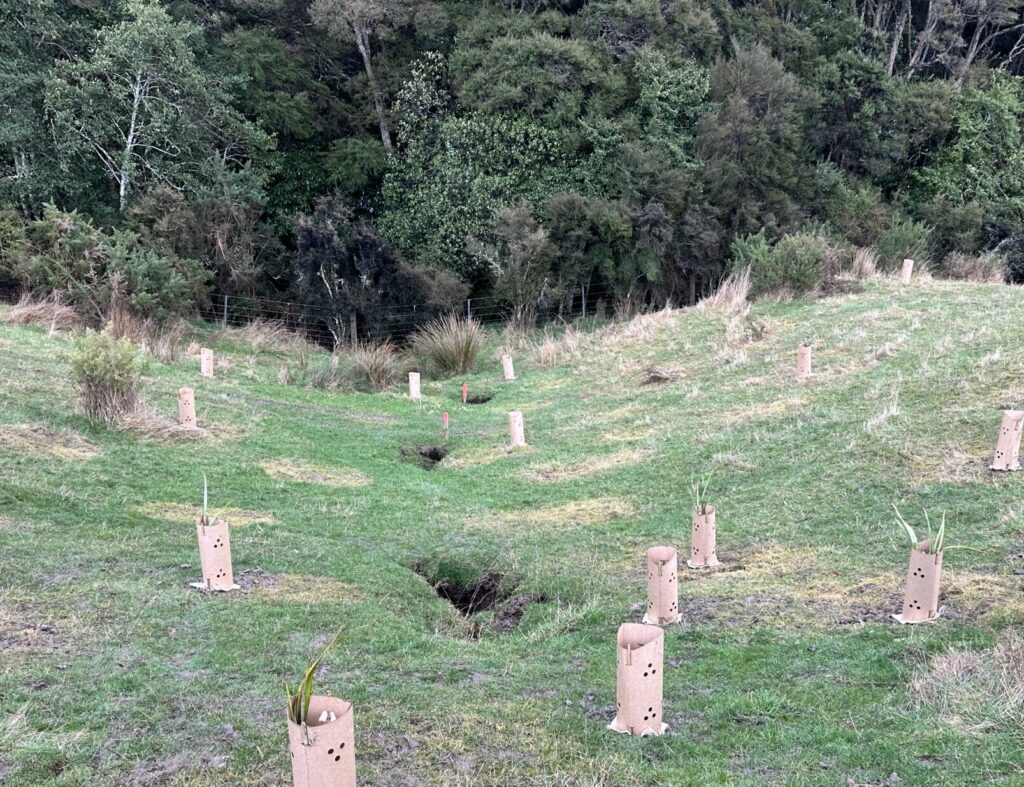
For both of us, it was useful to have me working on the project (rather than being just a disconnected owner). I learned more about my property. We were able to discuss options and agree on solutions. One example was at the top of the hill leading towards the southern boundary.
Glen asked me if I was going to have any rest areas along the walking track. I said I’d thought about it, but was going to wait until the track was made, to determine the best locations. He said that the top of the hill provided a good view down the hill, across the forest in the existing gully, and up the other side (towards the road) where more Kauri trees would be planted. Great idea I said, so he selected plants that when mature, would not block the view he described.
Working continuously all day, come 4 o’clock we were looking forward to winding up – all except Glen. He kept grabbing trees off the side-by-side and placing them on the ground, meaning that we had to complete the planting to protect them from any hares. “Come on. It’s only only 10 trees each.” as we planted another 50 trees for the day. “50 at 4” was a recurring event.
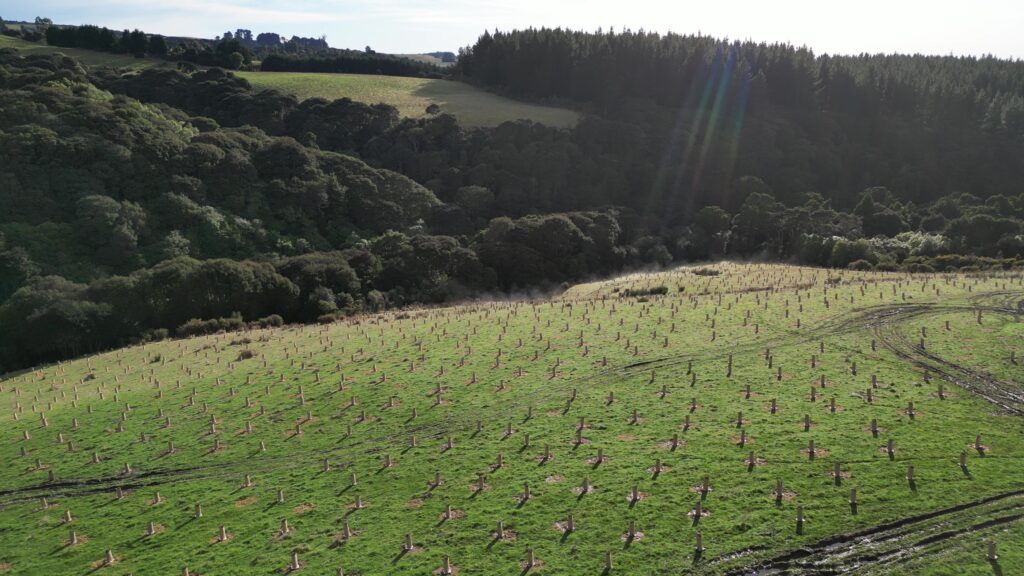
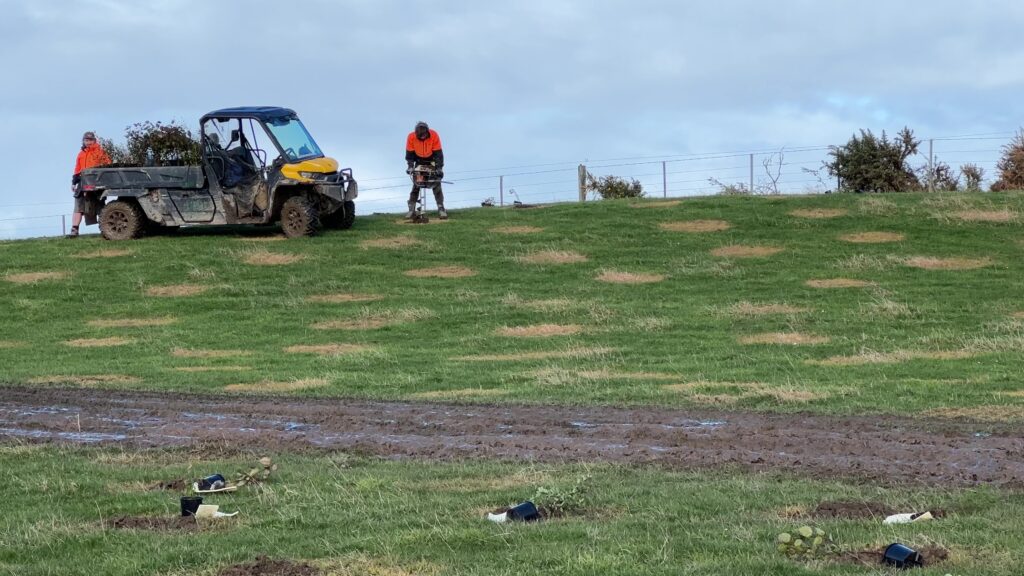
The walking track I pegged out in May 2023 became the primary route for the side-by-side to transport the trees, guard kits and equipment from the sheep yards to where we were planting. Using the marked track protected the sprayed planting circles from disappearing under track marks.
There were some diversions off the track. I expect they will be needed again when the Kauri trees are planted, but they’ll be planted in with trees and won’t be needed thereafter.
The ground was soft and muddy along the track. Due to the amount of rain, one of the trailers couldn’t be towed because the ground was too soft. We had to wait until towards the end of the planting program to move it.
The 4-wheel drive side-by-side handled the conditions surprisingly well. It was so much more useful than a quad bike. Glen’s side-by-side also had a long deck, so we could move plants without having to tow the trailer.
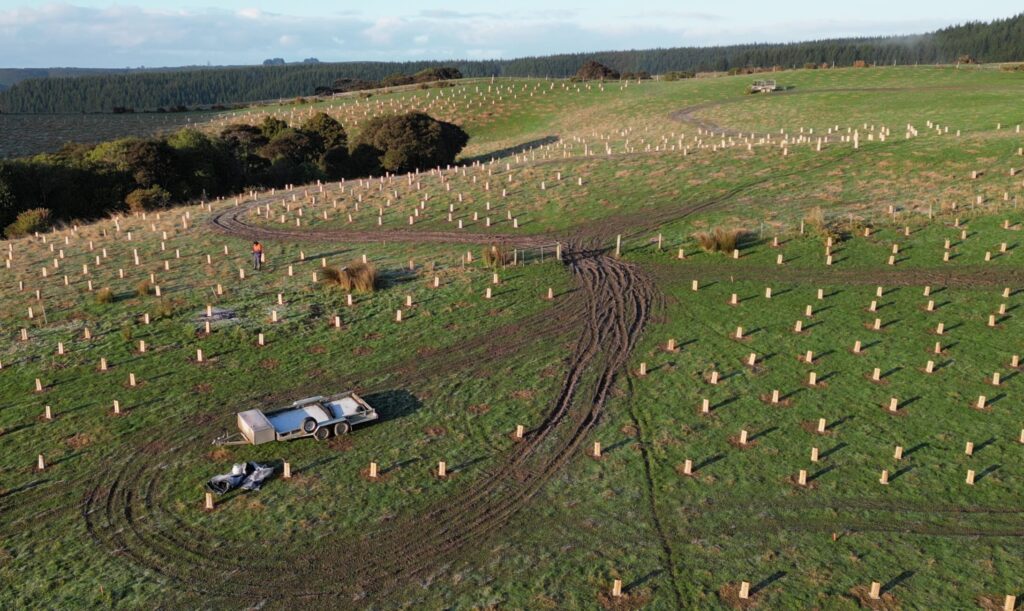
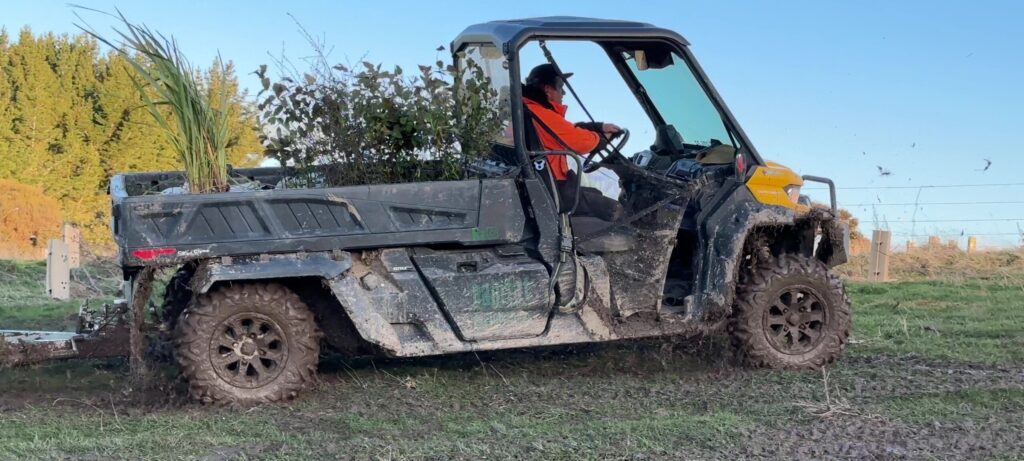
One night it snowed heavily enough for Dunedin Police to warn motorists not to travel on the roads due to the icy conditions. The tree guards did their job of protecting the young trees from the worst of the snow.
Flurries of snow continued on and off for the rest of the morning, but following that fall, the weather improved over the rest of the planting period.
Irrespective of the weather, Glen Riley only ever wore shorts. He told us that on one occasion, when he was guiding tourists groups around a Yellow Eyed penguin colony, a tourist tipped him $100 so he could go and buy some trousers! No evidence of that ever happening. He’s getting married next year, so I look forward to the wedding photos.
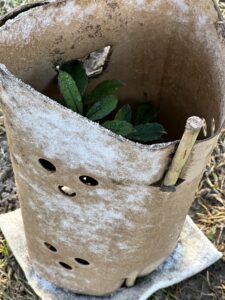
At first, the planting task seemed never-ending, but day-by-day, I could look back over the ground and see meaningful progress.
The existing fencing was untouched, and we planted over three paddocks. Finishing a paddock certainly gave me a sense of satisfying progress.
After 13 working days, the last tree was planted, and the site cleaned up. Although the area was along the property’s southern boundary, far from the road, the tree guards can still be seen, looking like some strange brown protrusions growing out of the ground. Knowing the effort we put in, including working through the bad weather, it gives me enormous satisfaction to see these trees in the ground.
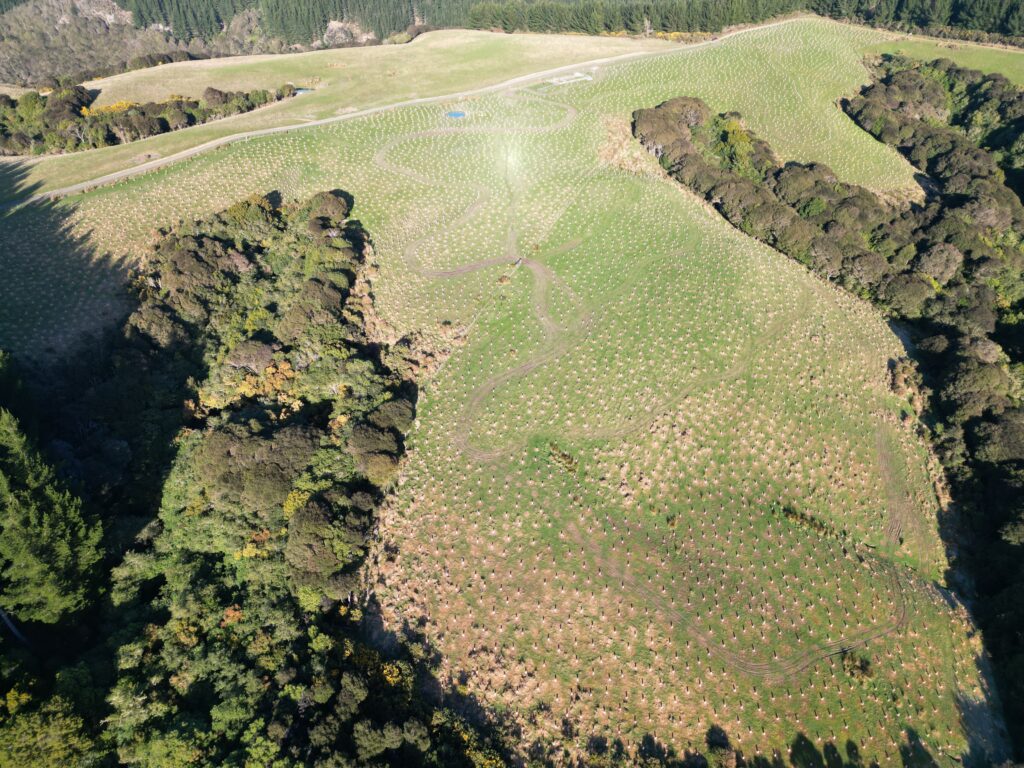

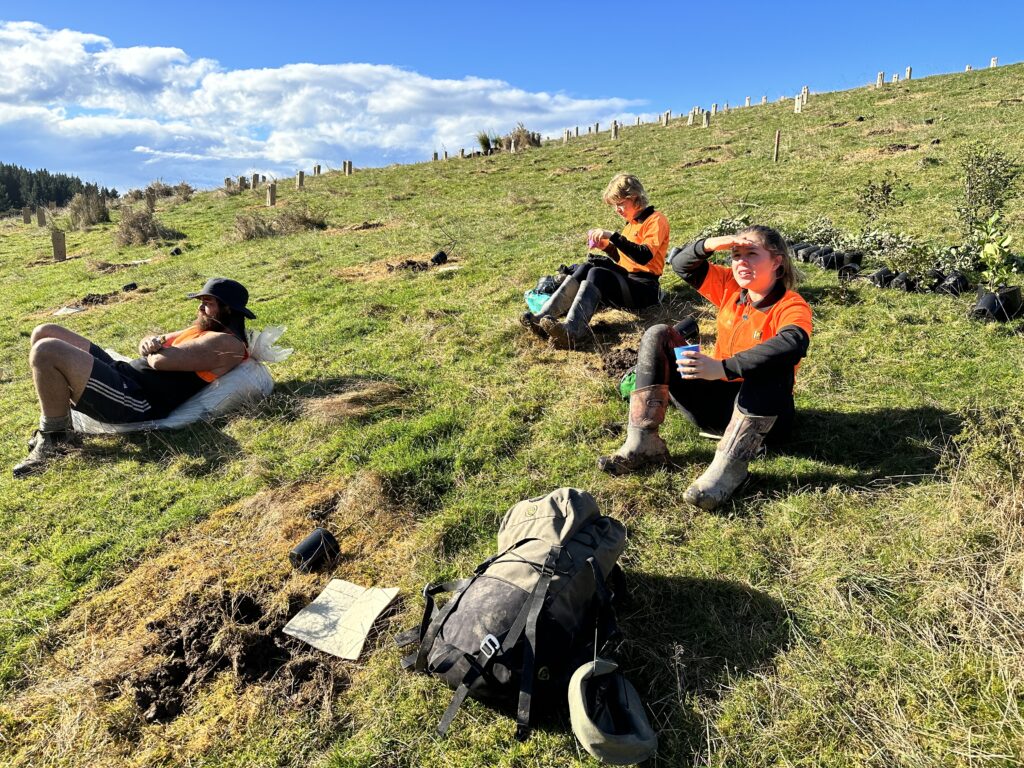
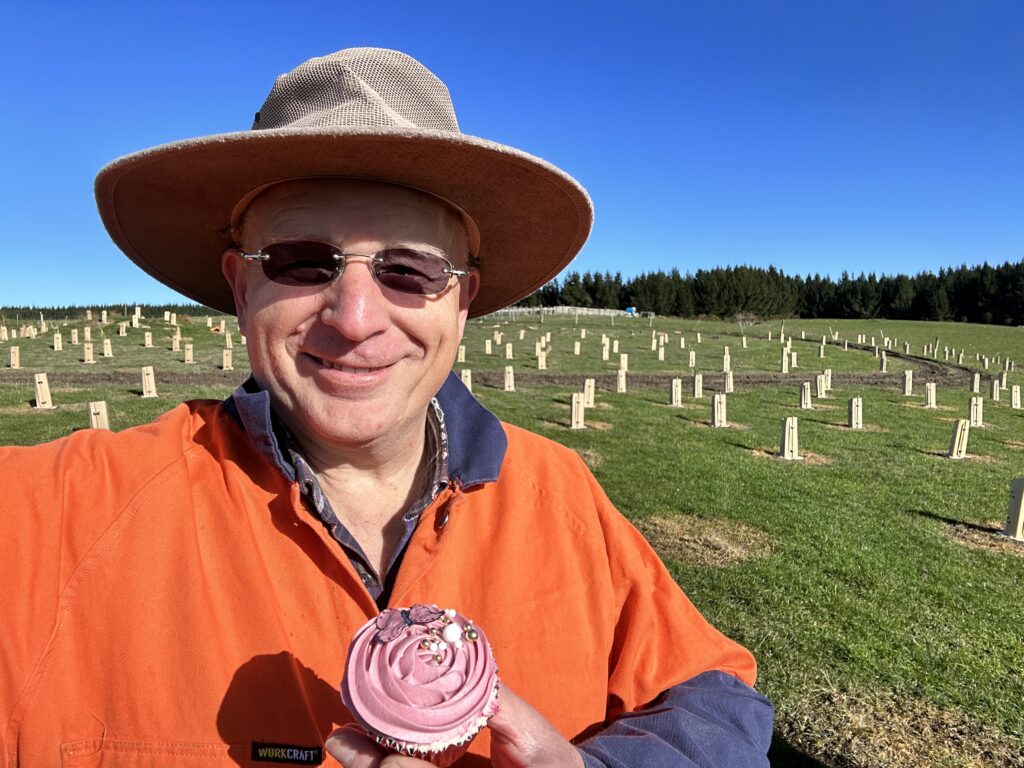
The video of the planting is KT013, which can be viewed here or on the Kauri Trees YouTube channel.
Gorse Be Gone
The planting crew didn’t work on the weekends, and so I used the remaining daylight at the end of the day and the weekends to cut down the gorse that grew along the interface between the forest and the pasture. Some of the gorse was more than a decade old, and 6 m tall. In parts, it was 10 m deep. I needed to work uphill, to ensure the fallen stems didn’t hide any uncut gorse bush. This meant that I also had the watch for thorns from falling stems.
Mike Gorinski with the help of my neighbour Martin Denton and his tractor, had sprayed most of the gorse in Area 1 earlier in the year, so although it was mostly dying, its existence stuck in my craw, and I wanted it gone. In amongst the thickets of gorse, there were indigenous trees struggling for a light, so taking down the gorse made me feel as if I was freeing the trees from captivity. Very satisfying.
I worked my way along most of the boundary of Area 1. There was a stand of gorse along the eastern boundary, mostly growing on my neighbour’s property, amongst the indigenous forest. I assume that the original seeding was likely to be from my property. I didn’t want it to re-seed back into my side of the fence, so I jumped the fence and spent a couple of days working my way through it all. The final clearing was the gorse around the pond in Area 2, and the associated channel leading down to the gully.
There’s more to do, and I expect I’ll be back in a year or two to cut it again. Hopefully the next round will be done with a brush cutter rather than a chainsaw.
My electric chainsaw was ideal for the task because there was much crawling and uncovering of forest litter to identify the actual start of the bush. A petrol chainsaw would have been cackling on idle, or stopped and started continuously. With the electric chainsaw, when my finger was off the trigger, it was stopped and silent. I had a rotation of three batteries, which I could recharge from the car accessory outlet, so that enabled me to work continuously.
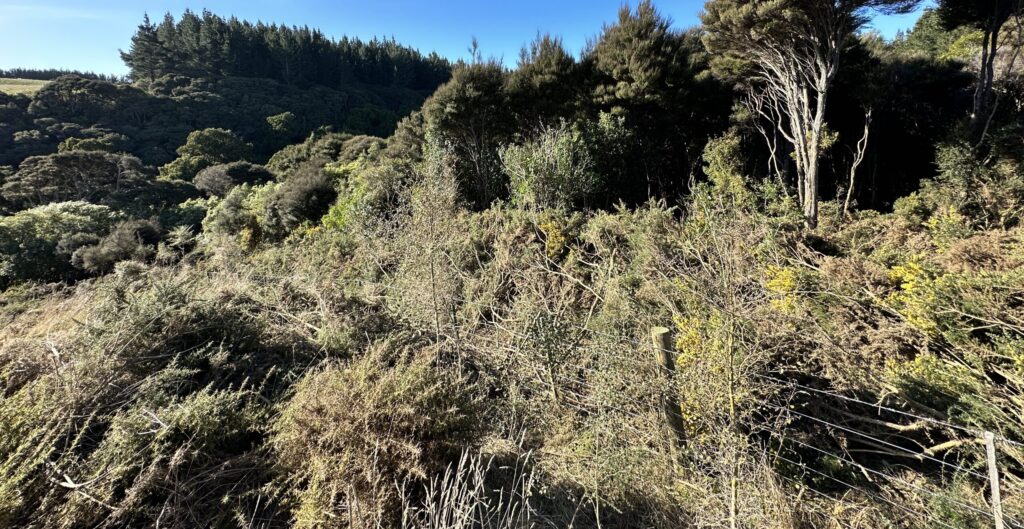
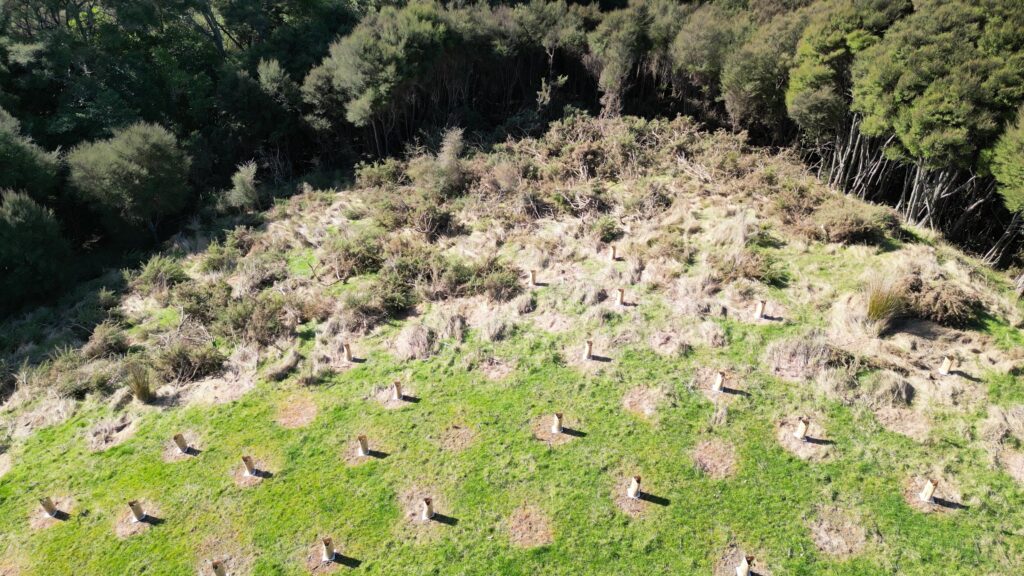
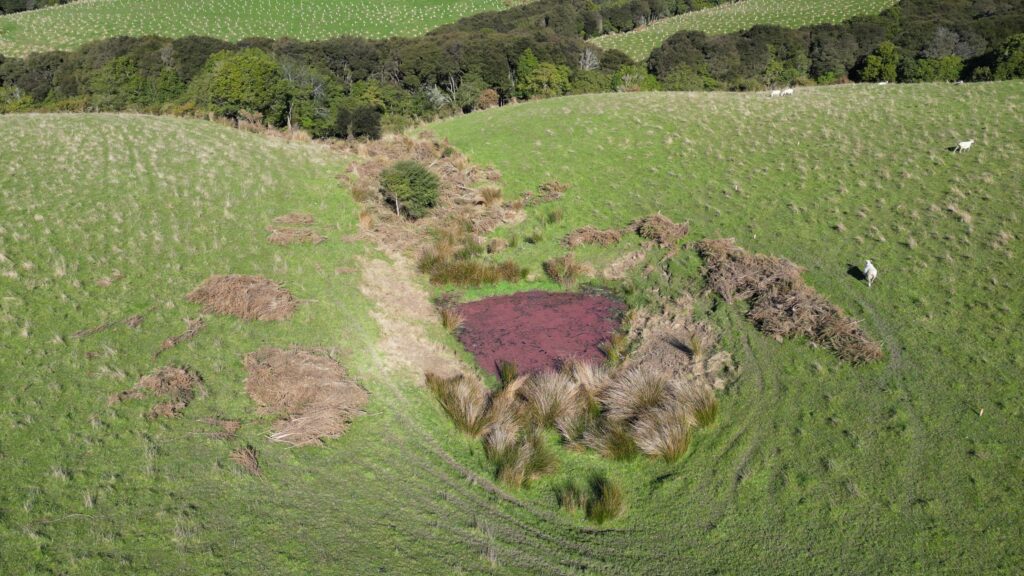
Ribbonwood Nurseries Visit
Phil Dunn and Vanessa from Ribbonwood Nurseries came out to the property near the end of the planting program. For the Nursery staff, the last they normally see of plants they’ve been cultivating (sometimes for years) is when they are driven out the nursery gate, so I was pleased to show Phil and Vanessa around. We walked over the planted Area 1, and Phil gave the final result his tick of approval. The spacing was right, as was the tree selection for the various ground conditions.
Having studied both botany and New Zealand birds, Phil impressed on me the benefits of having a greater variety of nurse trees, not specifically for the Kauri trees, but to support a whole ecosystem, including birdlife. He described some land areas where only 3 or 4 varieties were planted. They often collapsed within 5 years – sometimes due to maintenance neglect but sometimes they just failed to create the required ecosystem for the area to become self-sustaining.
It was Phil’s second visit to the property. He visited in 2022, so he knew the species growing in the gully. This influenced his species selection (together with the need to supply suitable nurse trees). Phil supplied 21 different varieties for Area 1, which gave Glen Riley more options to select the best plant for the specific location. The wider range of flora will also encourage greater diversity in birdlife, which will be an important future mechanism for natural seed dispersion.
The broad selection of nurse trees means there will be a seamless transition between the existing and new forest areas, with one exception: Kowhai. Kowhai trees once were common in Otago, but most were felled for their timber. So adding Kowhai back into the mix is consistent with historical varieties, supports tui, bellbirds, kaka, and kereru (NZ pigeon), and will provide an enticing blaze of yellow within the forest (far more attractive than the yellow gorse bush flowers!). One hundred Kowhai trees were planted, with Glen Riley planting a group around the pond. This will provide an attractive yellow reflective image as the trees mature and flower.
Together with Glen Riley, we walked over Area 2 to check the ground condition and discuss the varieties and quantity estimates for the next round of planting in May 2025. I asked for more Totara and Rimu, and we’ll continue to add to the 100 Kowhai already planted. The rest of the decisions, I left with the experts.
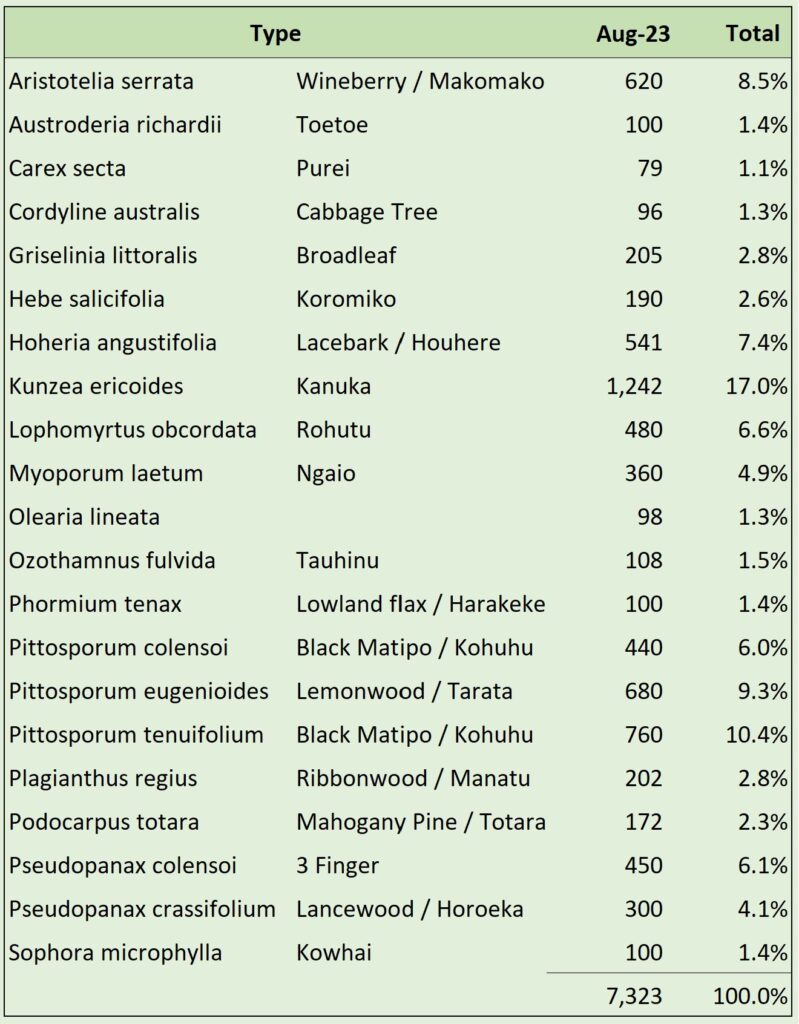
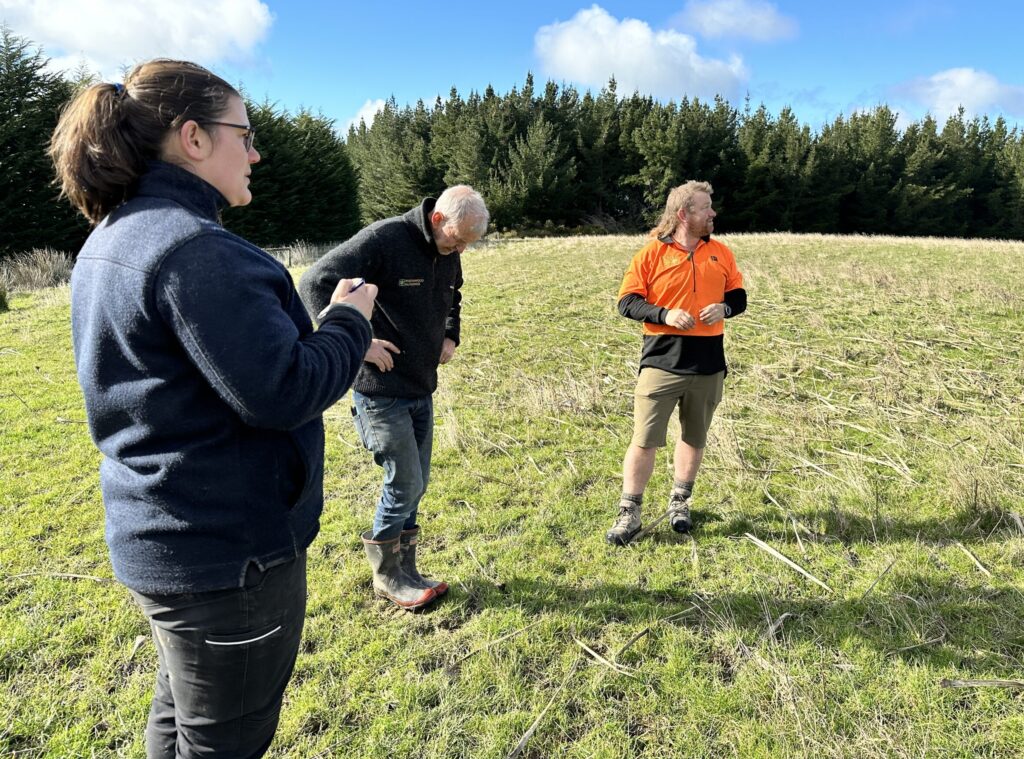
The First Kauri Tree
As Phil Dunn was leaving the property, he messaged me saying that he’d left something for me by the trailer. As we walked back at the end of the day, I discovered his gift – a Kauri tree that he had growing at the nursery. What a surprise! It’s probably about 5 years old.
On my first visit to Ribbonwood Nurseries, I had seen half a dozen trees growing in pots, ready for sale. I was envious of the size, given I was starting with seeds, but now I’m the proud owner of one of them.
There’s a small open space down near the pond at the bottom of the main gully. It’s sheltered from the wind and gets sunshine. This is where I planted my first and only tree in August 2023.
The video of the Kauri tree planting is KT017, which can be viewed here or on the Kauri Trees YouTube channel.
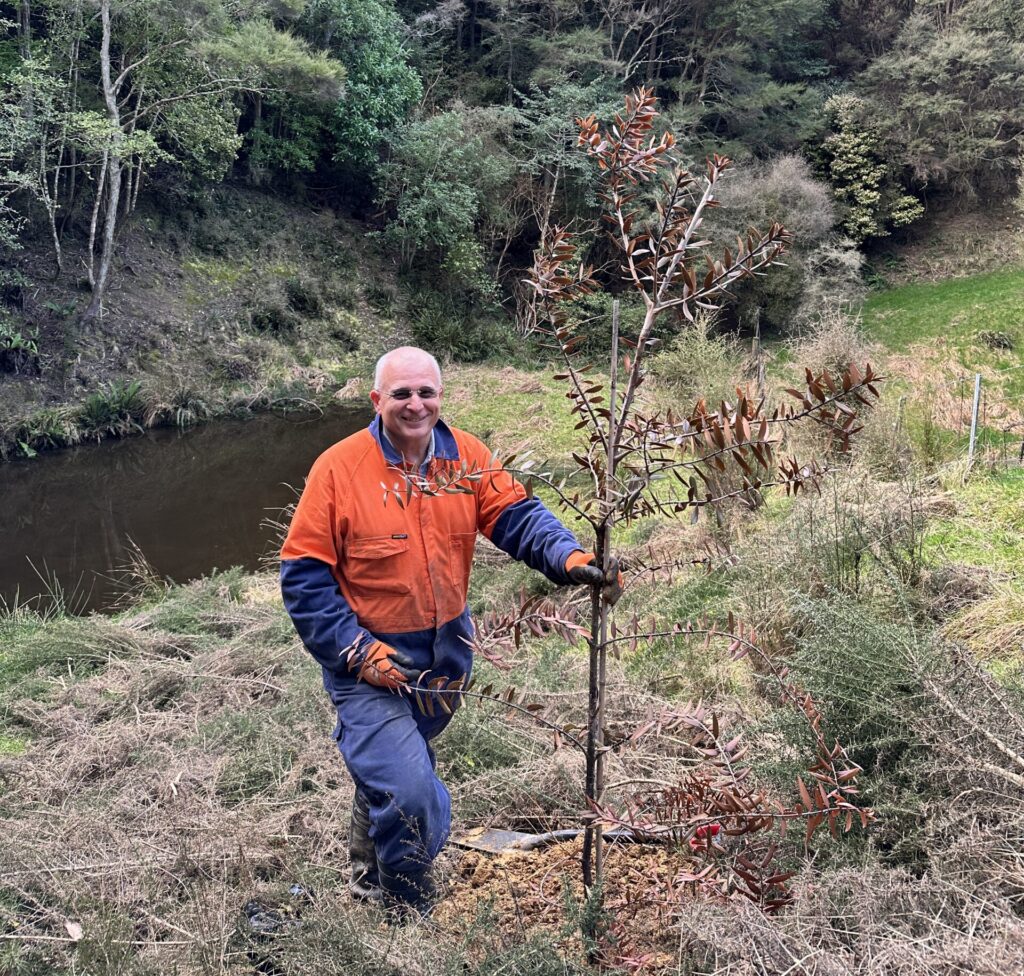
23 October 2023 Update
Despite what I thought was a sheltered area, the strong winds during October were too much for the Kauri sapling. My kind neighbour Elaine, together with Dave McFarlane generously staked and supported the tree.
Trees need to grow roots that will secure it against high winds, and the flexing of the trunk stimulates root expansion and strength. Ties to stakes inhibit the root growth and make mature trees more susceptible to toppling in high winds, so I’ll monitor the ties and relax them as the trunk strengthens.
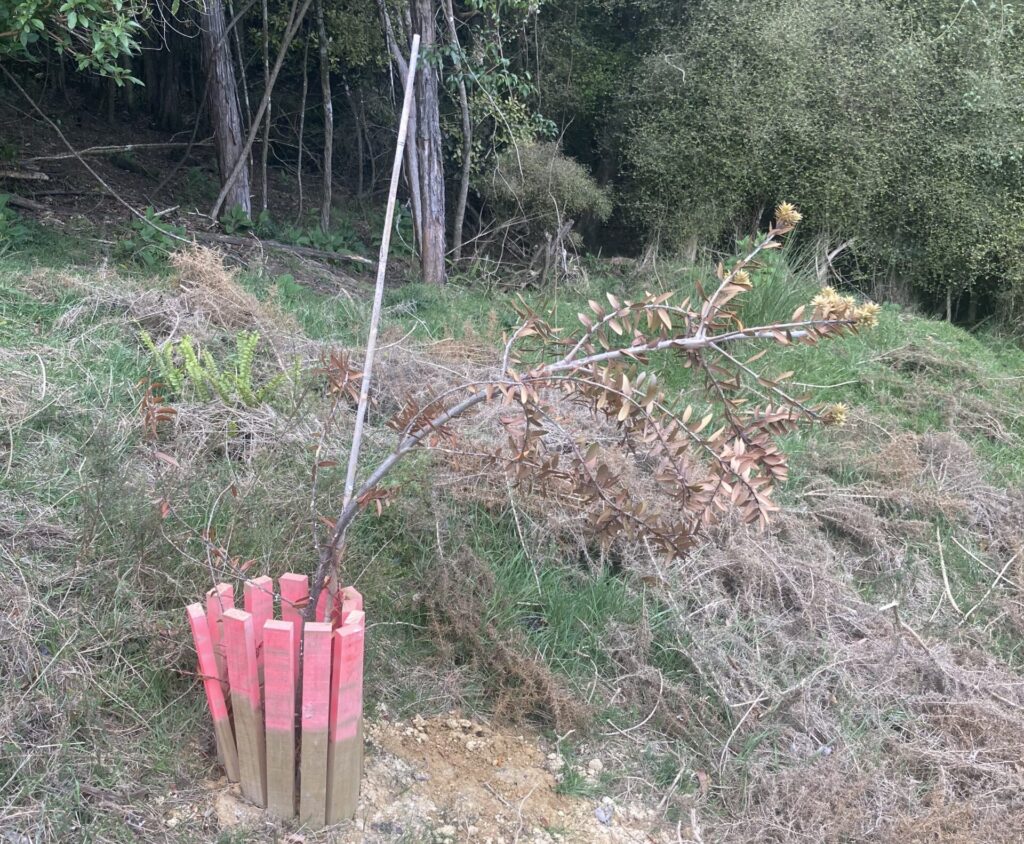
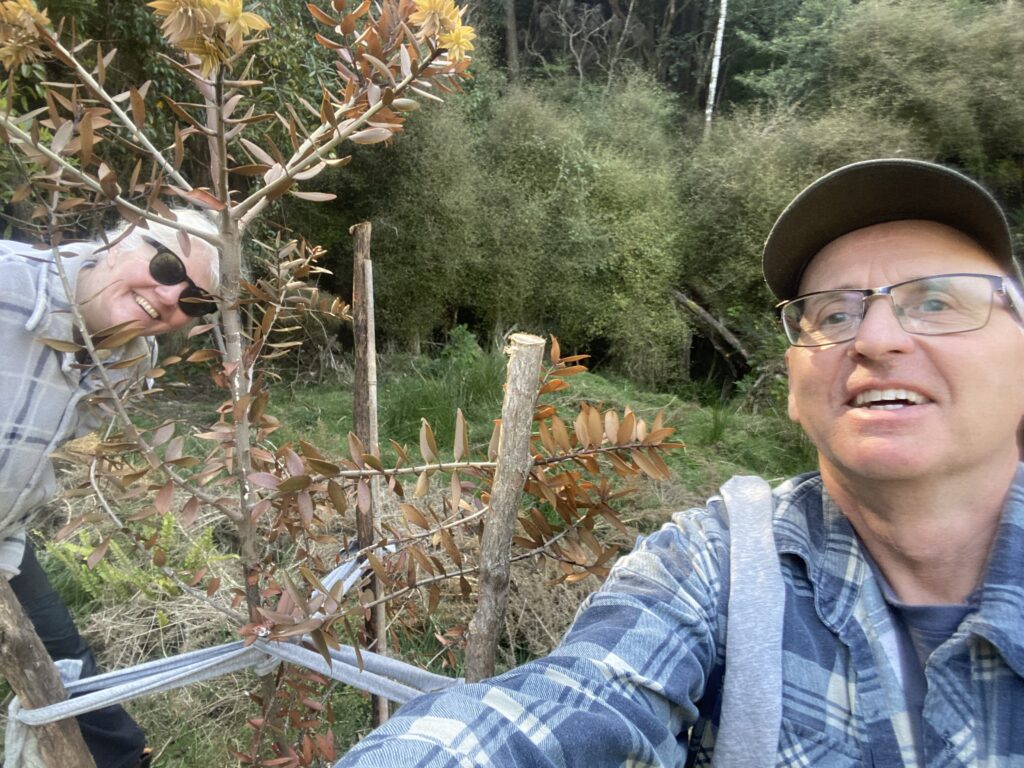
End-of-Month Review
Before I left to return to Melbourne, I walked over Area 1. The first trees had been in the ground for 4 weeks. Thankfully, I didn’t run across any dead plants, but I’m expecting 10% ~ 20% losses. Some of the young leaves near the top of the tree guards had been burned by the frost, but the leaves further down the stem seemed to be OK. Other trees had put on new growth, which was very exciting to see.
Some days of gentle rain helped bed-in the trees, and hopefully the woollen mats will keep the immediate ground from drying out too much over the first summer. The tree guards will also provide some shade. Fingers crossed it will all go well.
My final task was to take GPS watermarked photos for the Emissions Trading Scheme application. It was a most enjoyable and satisfying experience. I’m so pleased I got stuck in and worked with everyone. I know I’m paying for it, but that doesn’t mean I can’t get my hands dirty and get better attached to the project.
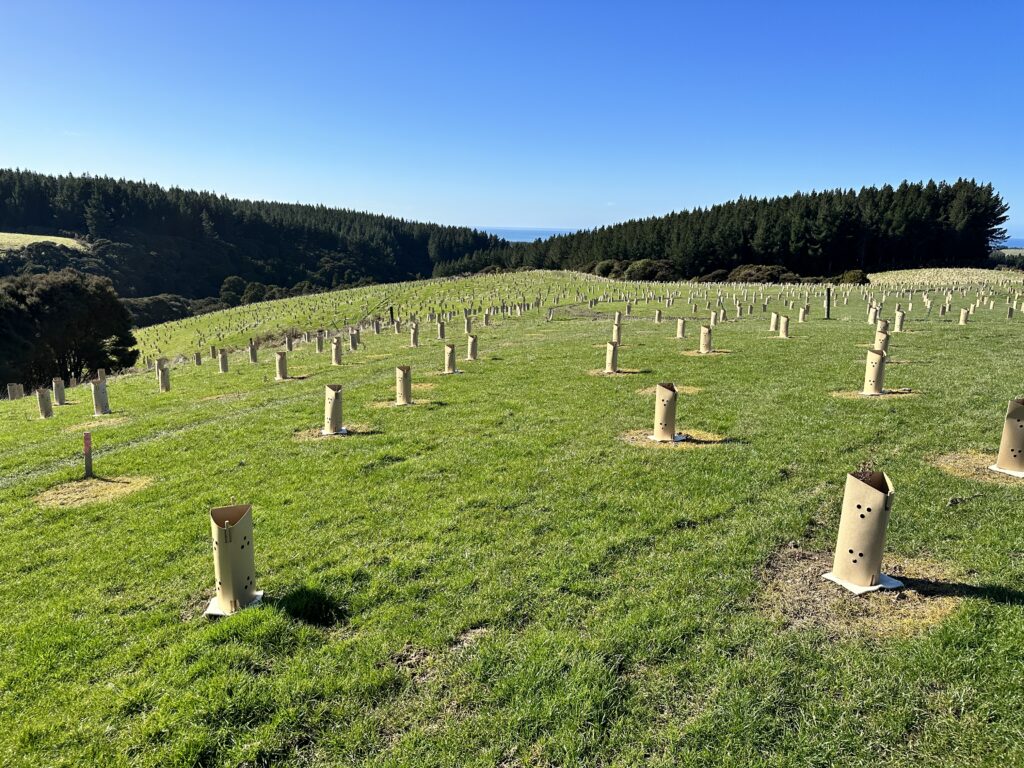
The wrap-up video for Area 1 is KT015, which can be viewed here or on the Kauri Trees YouTube channel.
12 November 2023
